Walther has always been a curious breed to me. They’ve been producing firearms for a long time and have succeeded enough to have helped form the icon that is James Bond with his sidearm of choice. Yet, whenever I’ve seen a Walther they had always been easily overlooked beyond “oh hey, a PPK!” It hadn’t been until the stars aligned and the PPQ was born that my perception of Walther changed in an instant.
The PPQ had been an evolution of the P99, another 9mm pistol which made it into Bond’s holster for the latter portion of the Pierce Brosnan films. For me, the PPQ is hands down the best striker-fired pistol on the market. I had reviewed the PPQ back in August of 2018, purchased a pair of them and have only come to like them more as time went on.
Then comes the day when I’m told “did you hear they’re ending the PPQ?”
I’m sorry, what?
It wasn’t that long ago that Walther came out with the Q4 and Q5 steel frame versions of the pistol. It wasn’t all that long ago that Walther came out with the PPQ, itself! Everything I had been led to believe was that the PPQ was doing quite well in the market. The next piece of intel I heard was that I was going to be angry, like my two were suddenly going to become obsolete. He wasn’t far off the mark in saying this but angry isn’t the right word.
What did replace the PPQ? That’d be the new Walther PDP, or Performance Duty Pistol, a pistol which from the outside looks quite a bit different from what came before it. There’s a lot to chew through here. Also of note, there is apparently a completely different “Walther PDP” which delivers pepper spray.
Based on a rumor that the PDP shared the PPQ M2’s magazine this was the first detail which I fact-checked, comparing a brand new PDP next to my PPQs. The mags are indeed identical…but the similarities didn’t stop there. One thing I feel the PDP did a good job with is the grip assembly, the ergonomics share quite a lot in common with the steel frame versions without having separate grip panels. I would have liked more positive texturing up front to match the rest but it does feel really good in the hand. Walther claims this grip has been optimized for red dot use, making it present more naturally and more quickly return to target.
Like the PPQ the backstrap is interchangeable, and is probably the exact same part. Taking the slides off of a PPQ and PDP revealed that under the hood they were just about identical as well. The PDP’s ejector has been beefed up somewhat and the trigger return spring is slightly different. The PPQ also has a curious “finger” by the ejector which would move when the trigger was pulled. Otherwise it seemed a case of “they’re the same, only different.”
Further examination showed that the barrels appeared to be the same, the recoil springs and guide rods appeared to be the same (my PPQ’s had a blue polymer end cap but newer PPQ’s seem to have switched to black which the PDP came with.) The slide endplates look like they might be compatible. It wouldn’t surprise me if the trigger assemblies were compatible as well. The PDP has a shorter extractor so those parts won’t swap, though out on the range they even felt the same when shooting.
Then I took this journey of discovery one step further. I put the PPQ’s slide onto the PDP’s frame and the PDP’s slide onto the PPQ’s frame. Both passed basic function checks. No hiccups, no rough spots, nada. They felt like they had come from the factory in such configurations. This only had me scratching my head more. If the PDP is the exact same gun as the PPQ on the inside then…why make it at all? What merited throwing out the former to give us this new version?
Could it be for cost saving? Somehow that doesn’t seem likely. Maybe for weight? Doubtful. Much like many of us over the last year the PDP seems to have put on some girth, a detail which is further suggested in that the PDP, unlike the PPQ, has a lightening cut on the bottom of the slide.
The PDP’s slide has been redesigned, overall looking similar in shape to the PPQ but with extra bulk built up around some fairly unique new “SuperTerrain” slide serrations and at the back. These serrations can run fairly deep around the middle and do provide a good gripping surface for indoor range use. From what I’ve read Walther believes these provide superior gripping in all conditions. What I’m a bit curious about is whether they might potentially snag while drawing from a holster.
One small detail about the compact model which I liked, the frame mounted Picatinny rail has three slots. Aesthetically this matches the three serrations in the front and back of the slide. It’s a small detail but helps lend to a feeling of synergy in the design.
Later versions of the PPQ were available with optics cuts so I doubt Walther thickened the PDP’s slide specifically for this reason. The PDP is optics ready as well, covered with a polymer panel which unfortunately has a very visible line interrupting where it mates to the slide. It rather seems as if Walther is expecting PDP owners to put some manner of red dot into their pistols rather than leave the panel in place. Given the iron sight situation this seems fairly likely.
The PPQ, and the P99 I believe, had a beautiful and innovative rear sight design. Push down a small plunger which also made up part of its windage adjustment and the sight would fall right out. It was such a simple hassle-free design that I wished it would have become the gold standard for handgun sights.
Why the PDP doesn’t make use of this system was really puzzling to me until I got clued in by their website, apparently the PDP makes use of the Glock 17/19 sight profile. What you gain from the factory is a windage and elevation adjustable rear sight via two teensy flathead screws. Despite having the elevation adjustment which the PPQ lacked I found the PDP’s open sight picture to be more awkward. There’s too much stuff happening in the back which gets in the way of your peripheral vision. Still, drilling bullseyes at thirty feet remains possible with the PDP and it seems like finding replacement sights won’t be much trouble. As much as I liked the PPQ’s sights there were not many alternatives on the market.
One area where the PDP does pull ahead of the PPQ is the trigger. The PPQ’s trigger was already fantastic but Walther managed to make the initial take-up feel even lighter. Both the PDP and PPQ felt to have the same range of motion and the same breaking point. Overtravel also felt the same both in resistance and distance of travel. The new one is also marked with another three letter acronym, PDT in this case. Walther’s really rocking a theme with these pistols lately.
The deeper I get into the PDP the more I have to question what Walther’s goals were here. What is its intended role? Competition seems unlikely, the trigger’s great but the shorter barrel and bulky sights don’t add up. Defensive use seems likely but with such a light trigger I start to wonder if it might be a bit too light for such a purpose. It almost seems to be one of those guns which tries to fit into every role, tick all of the boxes.
I would have loved to see Walther follow Sig’s modular trigger design with these pistols. If there was some way to get the frame separately for PPQ owners it would have been a great upgrade. What the PDP brings as an entire package has me feeling regrettably torn. I don’t mean to be hard on the PDP but it happens to be taking the place of a favorite, what I considered the very best of the striker-fired breed, and that’s some awfully big shoes to fill. If the steel framed Q’s are still being made and the PDP is functionally identical to the PPQ, why not make both?
Criticism aside, the PDP IS still a good gun. It has what I’d consider the nicest factory polymer striker fired trigger currently available and the newly shaped grip feels like a step in the right direction. The problem is that compared to what came before, the PDP hasn’t quite managed to maintain the bar in my eyes. A few improvements and a few areas which didn’t agree with me places the PDP one step behind its predecessor, though ultimately it is a fairly minor step.








